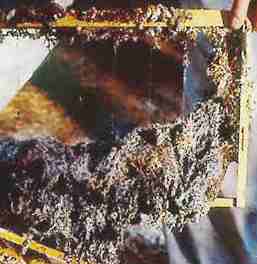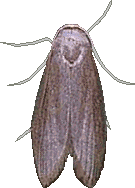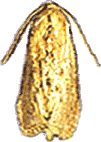| |
Waxmoth, also Known as Wax Moth
Achroia Grisella (lesser) & Galleria Mellonella (greater)
Waxmoth are not parasites or predators of bees, but they are a nuisance to
beekeepers as they destroy comb that is not in actual use by the bees as the picture below
right shows.
|
|---|

 Lesser Waxmoth Achroia Grisella (near right)... Is by far the most common type
and by sheer weight of numbers it probably causes the most damage.
Lesser Waxmoth Achroia Grisella (near right)... Is by far the most common type
and by sheer weight of numbers it probably causes the most damage.
 Greater Waxmoth Galleria Mellonella (left)... Is less common, but individuals are
capable of doing many times as much damage as the lesser type. It's larvae are so voracious
and numerous that they can wreak massive damage in a short time. The lasting damage to hive
woodwork is also much more severe than for the lesser species.
Greater Waxmoth Galleria Mellonella (left)... Is less common, but individuals are
capable of doing many times as much damage as the lesser type. It's larvae are so voracious
and numerous that they can wreak massive damage in a short time. The lasting damage to hive
woodwork is also much more severe than for the lesser species.
The debris has an unpleasant smell, cleaning up the damage takes valuable time
and the wax itself is lost as a product.
As far as the bees are concerned, in the natural situation wax moths are a method
by which old comb, which may carry disease, is destroyed thus recovering space in the nest
for new comb after the abandonment of the original old ones.
Beekeepers often consider the wax moth as a nuisance, particularly in stored comb.
Young larvae tunneling just underneath the cappings can cause leakage and weeping of honey.
But in general wax moths are only a big problem in weak colonies, or those that are
neglected.
The links above left will give you a good idea of how to deal with them, but do
not expect to be able to eliminate them entirely, however by observing hygiene and being
vigilant you will reduce the damage that they cause to an acceptable level. Those
beekeepers who claim that wax moth will kill colonies are probably trying to cover up their
own miss-management. Strong, well managed colonies will themselves do most of the work
required to limit the pest.
Originated... 24 January 2002,
Written... 09 to 11 June 2002,
Upgraded... 30 April 2005,
|

 Lesser Waxmoth Achroia Grisella (near right)... Is by far the most common type
and by sheer weight of numbers it probably causes the most damage.
Lesser Waxmoth Achroia Grisella (near right)... Is by far the most common type
and by sheer weight of numbers it probably causes the most damage.
 Greater Waxmoth Galleria Mellonella (left)... Is less common, but individuals are
capable of doing many times as much damage as the lesser type. It's larvae are so voracious
and numerous that they can wreak massive damage in a short time. The lasting damage to hive
woodwork is also much more severe than for the lesser species.
Greater Waxmoth Galleria Mellonella (left)... Is less common, but individuals are
capable of doing many times as much damage as the lesser type. It's larvae are so voracious
and numerous that they can wreak massive damage in a short time. The lasting damage to hive
woodwork is also much more severe than for the lesser species.